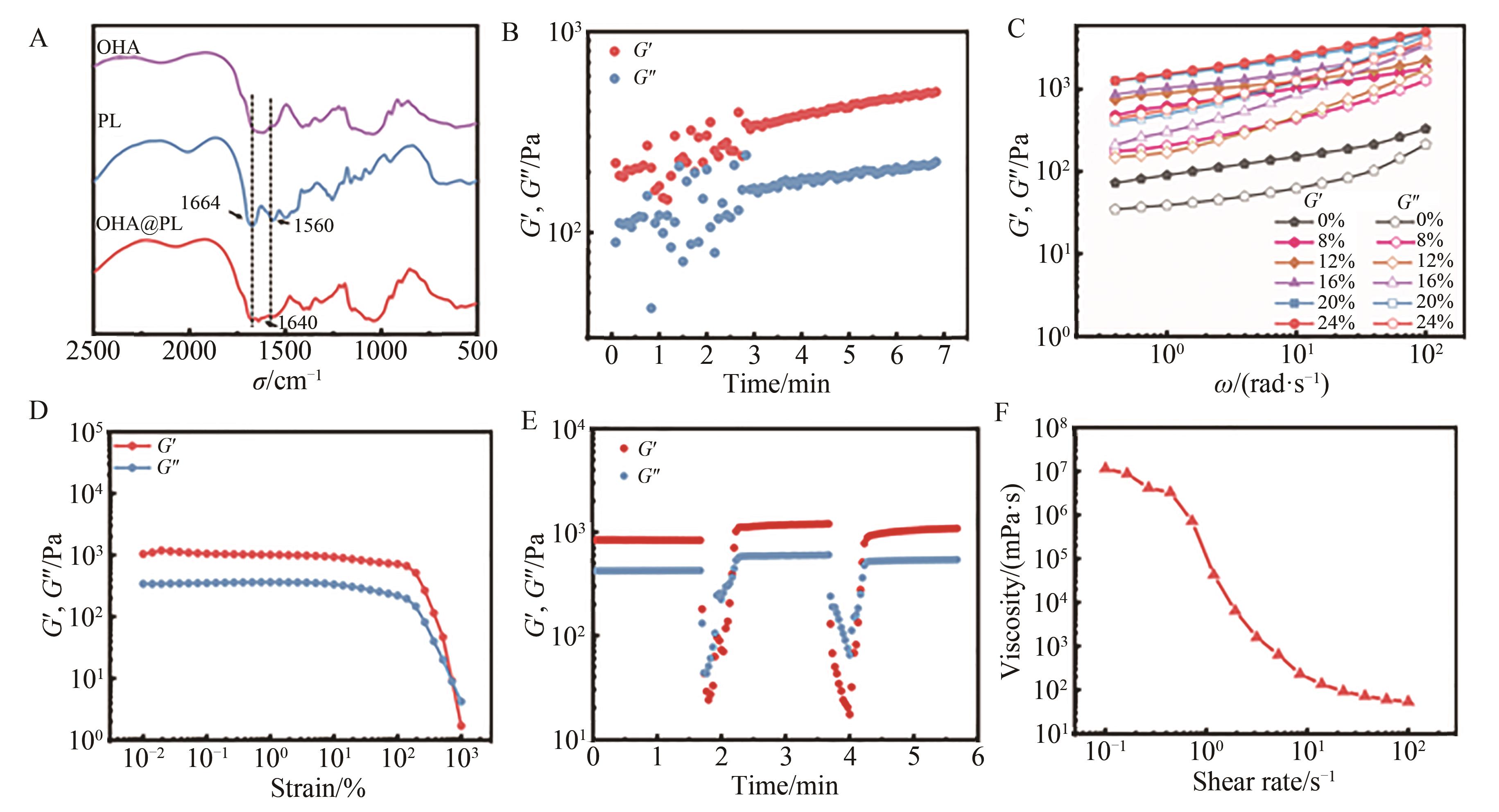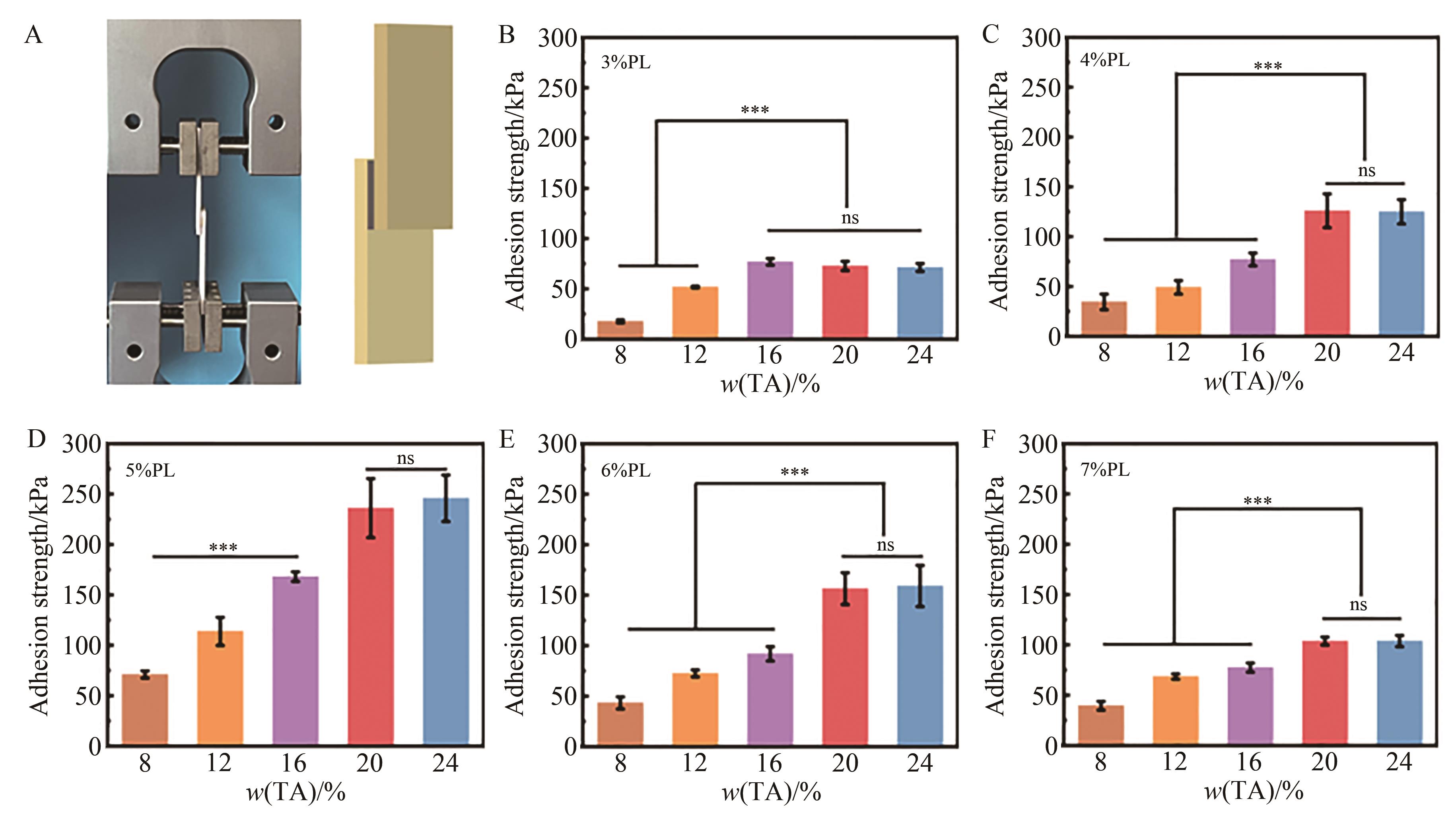
Chinese Journal of Applied Chemistry ›› 2023, Vol. 40 ›› Issue (9): 1258-1266.DOI: 10.19894/j.issn.1000-0518.230045
• Full Papers • Previous Articles Next Articles
Preparation and Properties of Mussel-Inspired Antibacterial Bone Adhesive
Jia-Hui LIU1,2, Bai-Chao AN3,4, Qiu-Yan YAN1( ), Shi-Fang LUAN1,2
), Shi-Fang LUAN1,2
- 1.State Key Laboratory of Polymer Physics and Chemistry,Changchun Institute of Applied Chemistry,Chinese Academy of Sciences,Changchun 130022,China
2.School of Applied Chemistry and Engineering,University of Science and Technology of China,Hefei 230026,China
3.School of Pharmacy,Guangdong Medical University,Dongguan 523000,China
4.School of Traditional Chinese Medicine,Southern Medical University,Guangzhou 510000,China
-
Received:2023-03-03Accepted:2023-07-12Published:2023-09-01Online:2023-09-14 -
Contact:Qiu-Yan YAN -
About author:qyyan@ciac.ac.cn
-
Supported by:the National Natural Science Foundation of China(22107099);the National Key Research and Development Program of China(2021YFC2101700);Natural Science Foundation of Guangdong Province of China(2018A030313355);the High-Tech Research & Development Program of CAS-WEGO Group
CLC Number:
Cite this article
Jia-Hui LIU, Bai-Chao AN, Qiu-Yan YAN, Shi-Fang LUAN. Preparation and Properties of Mussel-Inspired Antibacterial Bone Adhesive[J]. Chinese Journal of Applied Chemistry, 2023, 40(9): 1258-1266.
share this article
Add to citation manager EndNote|Ris|BibTeX
URL: http://yyhx.ciac.jl.cn/EN/10.19894/j.issn.1000-0518.230045

Fig.1 (A) Schematic illustration of fabrication of bone adhesive; (B) Schematic illustration of the synthesis of OHA; (C) FT-IR spectra of HA and OHA; (D) 1H NMR spectra of HA and OHA

Fig.2 (A) FT-IR spectra of OHA@PL;(B) Gelation process monitoring of OHA@PL@TA by rheological analysis; (C) Amplitude sweep results of OHA@PL@TA with different mass fraction of TA; (D) Strain sweep results of OHA@PL@TA; (E) Oscillation strain sweep of OHA@PL@TA followed by time sweep with high strains and low strains; (F) Viscosity change of OHA@PL@TA with the increase of shear rate

Fig.3 (A) Experiment set-up of lap-shear adhesion strength test. The lap-shear adhesion strength of OHA@PL@TA with different of the concentration of TA, when the concentration of PL respectively was 3%(B), 4%(C), 5%(D), 6%(E) and 7%(F) (***represents P<0. 001,ns represents P>0.05, n=3)

Fig.4 (A) Experiment set-up of end-to-end adhesion strength test. The end-to-end adhesion strength of OHA@PL@TA with different of the concentration of TA, when the concentration of PL respectively was 3%(B), 4%(C), 5%(D), 6%(E) and 7%(F)(*represents P<0.05,***represents P<0.001,ns represents P>0.05, n=3)

Fig.5 (A) Images of survival S.aureus clones on the culture plate after being co-cultured with samples; (B) Images of survival E.coil clones on the culture plate after being co-cultured with samples; (C) S.aureus and (D) E.coli with filtering papers incubated with leach liquor of samples placed on the agar petri dish to analyse the inhibition zone (Zone 1, 2, 3 and 4 stand for control, OHA, OHA@PL and OHA@PL@TA group, respectively). Quantitative results of S.aureus(E) and E.coli(F) co-cultured with PBS and those samples, respectively (***represents P<0.001, n=3)

Fig.6 (A) Live/Dead staining of MC-3T3 after treating with samples for 24 h; (B) Cell viability of MC-3T3 treated with samples for 24 h (ns represents P>0.05, n=3)
| 1 | ZHANG M R, LIU J X, ZHU T T, et al. Functional macromolecular adhesives for bone fracture healing[J]. ACS Appl Mater Interfaces, 2022, 14(1): 1-19. |
| 2 | KOONS G L, DIBA M, MIKOS A G. Materials design for bone-tissue engineering[J]. Nat Rev Mater, 2020, 5(8): 584-603. |
| 3 | TANG J C, XI K, CHEN H, et al. Flexible osteogenic glue as an all In one solution to assist fracture fixation and healing[J]. Adv Funct Mater, 2021, 31(38): 2102465. |
| 4 | BAI S M, ZHANG X L, LV X L, et al. Bioinspired mineral-organic bone adhesives for stable fracture fixation and accelerated bone regeneration[J]. Adv Funct Mater, 2019, 30(5): 1908381. |
| 5 | XU L J, GAO S, ZHOU R B, et al. Bioactive pore-forming bone adhesives facilitating cell ingrowth for fracture healing[J]. Adv Mater, 2020, 32(10): e1907491. |
| 6 | 王绪凯, 杨佳臻, 丁建勋. 双网络增强手性超分子水凝胶促进成骨[J].应用化学, 2022, 39(10): 1627-1628. |
| WANG X K, YANG J Z, DING J X. Double network-enhanced chiral supramolecular hydrogel to promote osteogenesis[J]. Chin J Appl Chem, 2022, 39(10): 1627-1628. | |
| 7 | HUANG B X, CHEN M J, TIAN J, et al. Oxygen-carrying and antibacterial fluorinated nano-hydroxyapatite incorporated hydrogels for enhanced bone regeneration[J]. Adv Healthc Mater, 2022, 11(12): e2102540. |
| 8 | HUANG W J, CHENG S, WANG X L, et al. Noncompressible hemostasis and bone regeneration induced by an absorbable bioadhesive self-healing hydrogel[J]. Adv Funct Mater, 2021, 31(22): 2009189. |
| 9 | ZHOU D, LI S Z, PEI M J, et al. Dopamine-modified hyaluronic acid hydrogel adhesives with fast-forming and high tissue adhesion[J]. ACS Appl Mater Interfaces, 2020, 12(16): 18225-18234. |
| 10 | ZHU D Q, WANG H Y, TRINH P, et al. Elastin-like protein-hyaluronic acid (ELP-HA) hydrogels with decoupled mechanical and biochemical cues for cartilage regeneration[J]. Biomaterials, 2017, 127: 132-140. |
| 11 | WU T L, CUI C Y, HUANG Y T, et al. Coadministration of an adhesive conductive hydrogel patch and an injectable hydrogel to treat myocardial infarction[J]. ACS Appl Mater Interfaces, 2020, 12(2): 2039-2048. |
| 12 | A S, XU Q, JOHNSON M, et al. An injectable multi-responsive hydrogel as self-healable and on-demand dissolution tissue adhesive[J]. Appl Mater Today, 2021, 22: 100967. |
| 13 | DEGEN G D, STOW P R, LEWIS R B, et al. Impact of molecular architecture and adsorption density on adhesion of mussel-inspired surface primers with catechol-cation synergy[J]. J Am Chem Soc, 2019, 141(47): 18673-18681. |
| 14 | WANG B, LIU J, NIU D Y, et al. Mussel-inspired bisphosphonated injectable nanocomposite hydrogels with adhesive, self-healing, and osteogenic properties for bone regeneration[J]. ACS Appl Mater Interfaces, 2021, 13(28): 32673-32689. |
| 15 | LIU Y H, ZHU Z, PEI X B, et al. ZIF-8-modified multifunctional bone-adhesive hydrogels promoting angiogenesis and osteogenesis for bone regeneration[J]. ACS Appl Mater Interfaces, 2020, 12(33): 36978-36995. |
| 16 | CHEN K W, LIN Q X, WANG L B, et al. An all-in-one tannic acid-containing hydrogel adhesive with high toughness, notch insensitivity, self-healability, tailorable topography, and strong, instant, and on-demand underwater adhesion[J]. ACS Appl Mater Interfaces, 2021, 13(8): 9748-9761. |
| 17 | YANG K, ZHOU X Y, LI Z L, et al. Ultrastretchable, self-healable, and tissue-adhesive hydrogel dressings involving nanoscale tannic acid/ferric ion complexes for combating bacterial infection and promoting wound healing[J]. ACS Appl Mater Interfaces, 2022, 14(38): 43010-43025. |
| 18 | ZHAO X D, PEI D D, YANG Y X, et al. Green tea derivative driven smart hydrogels with desired functions for chronic diabetic wound treatment[J]. Adv Funct Mater, 2021, 31(18): 2009442. |
| 19 | KIM K, SHIN M, KOH M Y, et al. TAPE: a medical adhesive inspired by a ubiquitous compound in plants[J]. Adv Funct Mater, 2015, 25(16): 2402-2410. |
| 20 | NAM S, MOONEY D. Polymeric tissue adhesives[J]. Chem Rev, 2021, 121(18): 11336-11384. |
| 21 | TIU B D B, DELPARASTAN P, NEY M R, et al. Cooperativity of catechols and amines in high-performance dry/wet adhesives[J]. Angew Chem Int Ed Engl, 2020, 59(38): 16616-16624. |
| 22 | KIM S, YOO H Y, HUANG J, et al. Salt triggers the simple coacervation of an underwater adhesive when cations meet aromatic π electrons in seawater[J]. ACS Nano, 2017, 11(7): 6764-6772. |
| 23 | ZHU H F, MEI X H, HE Y Y, et al. Fast and high strength soft tissue bioadhesives based on a peptide dendrimer with antimicrobial properties and hemostatic ability[J]. ACS Appl Mater Interfaces, 2020, 12(4): 4241-4253. |
| 24 | GUO H L, HUANG S, XU A D, et al. Injectable adhesive self-healing multiple-dynamic-bond crosslinked hydrogel with photothermal antibacterial activity for infected wound healing[J]. Chem Mater, 2022, 34(6): 2655-2671. |
| 25 | JIN X, XIONG Y H, ZHANG X Y, et al. Self‐sdaptive sntibacterial porous implants with sustainable eesponses for infected bone defect therapy[J]. Adv Funct Mater, 2019, 29(17): 1807915. |
| 26 | SUN L W, SONG L J, LUAN S F, et al. Progress in photo-initiated living graft polymerization of biomaterials[J]. Acta Polym Sin, 2021, 52(3): 223-234. |
| 27 | LIU Z T, YI Y Z, WANG S J, et al. Bio-inspired self-adaptive nanocomposite array: from non-antibiotic antibacterial actions to cell proliferation[J]. ACS Nano, 2022, 16(10): 16549-16562. |
| 28 | DING M, ZHAO W, SONG L J, et al. Stimuli-responsive nanocarriers for bacterial biofilm treatment[J]. Rare Met, 2022, 41(2): 482-498. |
| 29 | CAO D, DING J. Recent advances in regenerative biomaterials[J]. Regener Biomater, 2022, 9: rbac098. |
| 30 | 刘慧, 刘骁, 曹远桥, 等. 氨基酸基聚合物在抗菌领域的研究进展[J]. 应用化学, 2021, 38(5): 559-571. |
| LIU H, LIU X, CAO Y Q, et al. Research progress on amino acid-based antimicrobial polymers[J]. Chin J Appl Chem, 2021, 38(5): 559-571. | |
| 31 | 孙振龙, 闫顺杰, 周容涛, 等. 基于抗菌肽的智能型抗菌涂层研究进展[J]. 应用化学, 2020, 37(8): 865-876. |
| SUN Z L, YAN S J, ZHOU R T, et al. Recent progress in the development of smart coatings based on antimicrobial peptides[J]. Chin J Appl Chem, 2020, 37(8): 865-876. |
| [1] | Yu-Jie MA, Ying-Xin ZHANG, Huan-Yan DAI, Zhi-Min XU, Bing HAN. Preparation and Properties of 3D Printed nHA/PEEK-AgNPs Composite Porous Scaffolds [J]. Chinese Journal of Applied Chemistry, 2023, 40(4): 536-545. |
| [2] | Wei-Na HAO, Chao ZHOU, Hai-Ping DI, Lin-Hong DENG. Preparation and Characterization of Graphene Oxide-Hyaluronic Acid-Polyethylene Glycol Composite Supramolecular Hydrogel [J]. Chinese Journal of Applied Chemistry, 2023, 40(12): 1672-1681. |
| [3] | Guo-Qing CAI, Jing-Ru DONG, Jun-Ming MO. Green Synthesis and Antibacterial Activity of N‑Benzyl Sulfoximines [J]. Chinese Journal of Applied Chemistry, 2023, 40(12): 1693-1699. |
| [4] | Xiao-Ming XIE, Jia-Qi ZHANG. Hydrogen Bond Interaction Driven Procyanidine Assembly into Underwater Adhesive with Antibacterial Activity [J]. Chinese Journal of Applied Chemistry, 2022, 39(10): 1533-1542. |
| [5] | YANG Jia-Qiang,WU Xue-Jiao, ZHOU Xu-Rong, DENG Ling, YANG Hong. Synthesis and Antibacterial Activities of Osthole Ester Derivatives [J]. Chinese Journal of Applied Chemistry, 2021, 38(8): 917-922. |
| [6] | Sha-Man LUO, Hao-Zhe SUN, Shi-Qiang YAN, Hui HUANG, Wei-Jia ZHANG, Jia WEI, Yan-Lei YU. Cell Biocompatibility of Photodeformable Azobenzene⁃containing Liquid Crystal Polymers [J]. Chinese Journal of Applied Chemistry, 2021, 38(10): 1371-1381. |
| [7] | XING Yayan, SHI Yuzhe, DENG Shixian, ZHAO Baihan, LIU Zhiguo. Preparation and Application of Catechin-Silver Nanocomposites [J]. Chinese Journal of Applied Chemistry, 2020, 37(9): 1062-1068. |
| [8] | YANG Jin,MA Qiseng,ZHONG Ying,ZHU Longbao,GE Fei,TAO Yugui,SONG Ping. Solid-Phase Synthesis of Cyclohexapeptide Thermoactinoamide A and Its Antibacterial Activity [J]. Chinese Journal of Applied Chemistry, 2019, 36(6): 677-682. |
| [9] | LING Huiping,CHEN Xiaoqing,XIE Shengnan,CHEN Yuejian,SHE Zhigang,LIN Yongcheng,TAO Yiwen. Dihydroisocoumarin Compounds from Endophytic Fungi of Rhizophora apiculata and Its Antibacterial Activity [J]. Chinese Journal of Applied Chemistry, 2018, 35(6): 708-713. |
| [10] | WEN Lijun, WANG Ying, LI Haixia, LI Juan. Synthesis and Antibacterial Activity of 5,6-Dimethyl-2,3-pyrazinedimethylformamide-Cu [J]. Chinese Journal of Applied Chemistry, 2016, 33(9): 1056-1060. |
| [11] | ZHAO Shengfang, CHEN Nianyou, ZHANG Hanmei, ZHANG Jing, LI Zaoying. Microwave Synthesis and Antibacterial Activity of Novel Asymmetric Porphyrin Matal Complexes from Substituted Piperonal [J]. Chinese Journal of Applied Chemistry, 2015, 32(5): 542-546. |
| [12] | FENG Jianhua, WU Gang. Synthesis, Structure and Antibacterial Activities of 4, 4', 6, 6'-Tetra(tert-butyl)-2, 2'-[ethylenedioxybis (nitrilomethylidyne)]diphenol and Its Cu(Ⅱ) Complex [J]. Chinese Journal of Applied Chemistry, 2015, 32(5): 557-561. |
| [13] | YANG Fengke, HAN Jian, WANG Yongchun, CHEN Fang. Synthesis and Biological Activity of Schiff Bases [J]. Chinese Journal of Applied Chemistry, 2015, 32(4): 392-398. |
| [14] | ZHANG Tongtong1, LU Junrui1*, FENG Zhongnian1, LIU Jinbiao1, MU Jiangbei1, HOU Juezhuo2, BAO Xiurong1, XIN Chunwei1, WANG Meijun1. Synthesis and Antimicrobial Activities of Novel 1,2,4-Triazole Glucoside Derivatives [J]. Chinese Journal of Applied Chemistry, 2014, 31(09): 1050-1057. |
| [15] | ZHANG Zhijian1*, KUANG Daizhi2, ZHANG Fuxing2, YU Jiangxi2, JIANG Wujiu2. Synthesis, Crystal Structure and Biological Activities of the Tris (2-methyl-2-phenyl) propyl Tin Trichloroacetic Acid Ester [J]. Chinese Journal of Applied Chemistry, 2014, 31(09): 1058-1062. |
| Viewed | ||||||
|
Full text |
|
|||||
|
Abstract |
|
|||||